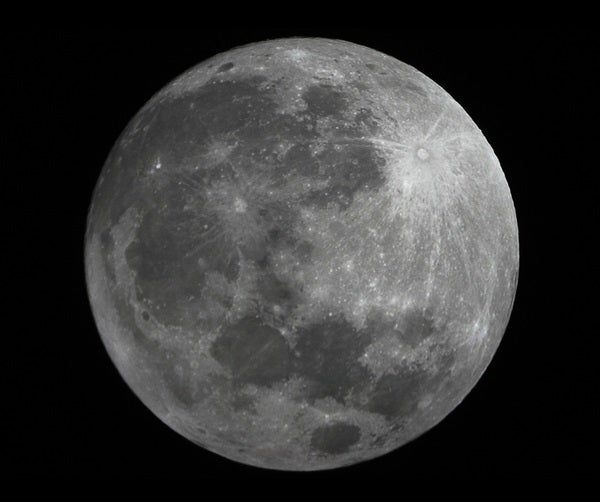The Geminid meteor shower peaked before dawn, but it should still put on an impressive show tonight. For the best views, wait until the Moon sets around 11:30 p.m. local time. Observers under a clear dark sky can expect to see a few dozen meteors per hour — an average of one every couple of minutes. The meteors appear to radiate from a spot just north of Castor, the bright star in the northern part of the constellation Gemini the Twins. This region passes nearly overhead from mid-northern latitudes around 2 a.m. local time, although conditions remain excellent from midnight until morning twilight commences.
A nearly First Quarter Moon passes 4° south of Mars this evening. The two bright objects dominate the southern sky after darkness falls and remain conspicuous until they set after 11 p.m. local time. This isn’t the only night worth viewing Mars, however. As twilight fades to darkness, the Red Planet appears nearly halfway to the zenith in the southern sky. The ruddy world shines brightly at magnitude 0.2 against the faint backdrop of Aquarius the Water-bearer. When viewed through a telescope, Mars appears 8″ across and might show a few subtle surface markings.
Saturday, December 15
First Quarter Moon occurs at 6:49 a.m. EST. The Moon doesn’t rise until shortly after noon local time, however, and by the time darkness sets in, our satellite appears 55 percent lit. It then lies in far southern Pisces, south of the Great Square of Pegasus.
Mercury lies 21° west of the Sun today, its greatest elongation during this current morning apparition. It rises nearly two hours before our star and climbs 10° above the southeastern horizon 45 minutes before sunrise. The innermost planet shines at magnitude –0.4, easily bright enough to see with the naked eye (though binoculars will help you pick it out of the twilight glow). When viewed through a telescope, Mercury’s 7″-diameter disk appears slightly gibbous.
Comet 46P/Wirtanen puts on a superb show in mid-December. This periodic visitor currently glows around 4th magnitude — bright enough to glimpse with the naked eye from a dark site and an easy target through binoculars. Wirtanen makes its closest approach to Earth tonight, swooping within 7.2 million miles of our planet. The comet resides among the background stars of Taurus the Bull, some 5° due east of the magnificent Pleaides star cluster (M45). This area remains visible nearly all night, but climbs highest in late evening.
Monday, December 17
A lone bright star now hangs low in the south during early evening. First-magnitude Fomalhaut — often called “the Solitary One” — belongs to the constellation Piscis Austrinus the Southern Fish. From mid-northern latitudes, it climbs 20° above the horizon at its best. How solitary is Fomalhaut? The nearest 1st-magnitude star to it, Achernar at the southern end of Eridanus the River, lies some 40° away. It doesn’t appear quite as isolated as normal this year, however, because Mars stands about 25° north of it.
Tuesday, December 18
Venus appears brilliant from the time it rises around 3:30 a.m. local time until close to sunrise more than three hours later. It stands about 25° above the southeastern horizon an hour before the Sun comes up. Gleaming at magnitude –4.8, the planet shines far brighter than any other object in the predawn sky. When viewed through a telescope, Venus spans 31″ and appears about 40 percent lit.
Wednesday, December 19
The variable star Algol in Perseus appears faintest at 2:47 a.m. EST tomorrow morning, when it shines at magnitude 3.4. Observers across North America should start watching it after darkness falls tonight if they want to witness its dramatic drop from peak brightness (magnitude 2.1). This eclipsing binary star runs through a cycle from minimum to maximum and back every 2.87 days, but the drop from peak brightness and subsequent rise lasts only about 10 hours. Algol appears in the east-northeast after sunset and passes nearly overhead around 9 p.m. local time.
Thursday, December 20
The nearly Full Moon passes through the background stars of the Hyades star cluster tonight. Use binoculars to best see the V-shaped star group frame Earth’s only natural satellite. The conjunction affords a good opportunity to witness the Moon’s motion. Early this evening, Luna sits just west of the Hyades, but by time they sink low in the west tomorrow morning, the Moon has pulled east of the cluster. As you gaze at our satellite tonight, take a minute to remember that today is the 50th anniversary of Apollo 8 leaving Earth on humanity’s historic first voyage to the Moon.
Friday, December 21
Mercury has started to dip lower in the predawn sky as its orbit carries it back toward the Sun. As it descends, Jupiter rises to meet it. This morning, the two stand less than 1° apart. At magnitude –1.8, Jupiter appears more conspicuous than magnitude –0.5 Mercury. Enjoy this pretty conjunction starting about 45 minutes before sunrise, when the pair lies 8° above the horizon. Those with binoculars might spot the 1st-magnitude star Antares 5° to Jupiter’s lower right.
Earth’s winter solstice occurs at 5:23 p.m. EST. At that moment, the Sun reaches its farthest point south in the sky. The solstice marks the official beginning of winter in the Northern Hemisphere, and tonight has more hours of darkness than any other. From mid-northern latitudes, however, the earliest sunset occurred about two weeks ago and the latest sunrise won’t happen until early January.
Full Moon officially arrives at 12:49 p.m. EST, but our satellite looks completely illuminated all night. You can find it rising in the east just after sunset and peaking in the south shortly after midnight local time. It dips low in the west by the time morning twilight begins. As the Full Moon closest to the winter solstice, it climbs higher in the sky than any other Full Moon during the year. It lies among the background stars of western Gemini tonight, near the feet of the Twins.
Sunday, December 23
Head outside in early evening this week and you can see the Big Dipper scraping the northern horizon. For latitudes north of about 40°, this conspicuous asterism never rises or sets (“circumpolar” in astronomical parlance), though December evenings find it at its lowest ebb. This means that the constellation on the opposite side of the North Celestial Pole, the familiar W-shaped Cassiopeia, currently rides highest in the sky.












